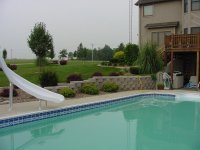MReeter
Platinum Member
bmac,had to build retaining walls also,I would leave at least 4' between pool and walls,closer 6'.A BX would be perfect for this project,the blocks we used were 90 lbs. each,our FEL was well worth its weight,also moved a lot of gravel to pour in the block cavities.The walls are about 4' at the highest point and have not moved an inch in 3 years,I recommend the heavier blocks,they are tougher the work with,a little higher priced,but will stay put for many,many years.


